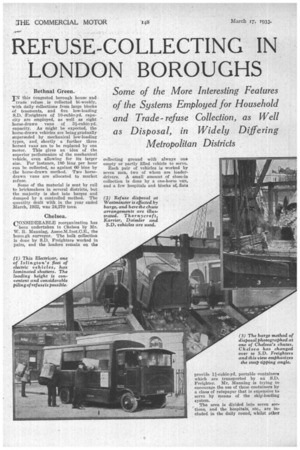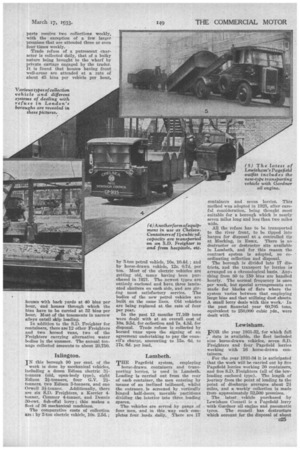REFUSE-COLLECTING IN LONDON BOROUGHS
Page 74

Page 75

Page 76

If you've noticed an error in this article please click here to report it so we can fix it.
. Bethnal Green.
IN this Congested borough house and trade refuse is collected biweekly, With daily collections from large blocks of tenements, and five low-loading S.D. Freighters of 1.0-cubic-yd. capacity are employed, as well as eight horse-drawn vans of 31-cubic-yd. capacity. As might be expected, the horse-drawn vehicles are being gradually superseded by mechanical low-loading types, and, shortly a further three horsed vans are to be replaced by one motor. This gives an idea of the superior performance of the mechanical vehicle, even allowing for its larger size. For instance, 180 bins per hour eau be collected, as against 60 bins by the horse-drawn method. Two horsedrawn vans are allocated to market refuse.
Some of the material is sent by rail to brickmakers in several districts, but the majority is shot into barges and dumped by a controlled method. The quantity dealt with in the year ended March, 1032, was 24,270 tons:
Chelsea.
CONSIDERABLE reorganization has been undertaken in Chelsea bY Mr. W. It. Manning, Assoc.M.Inst.C.E-, the borer gh surveyor. The bulk collection is done by S.D. Freighters worked in pairs, and the loaders remain on the collecting ground with always one empty or partly filled vehicle to serve.
Each pair of vehicles is worked by seven men, two of whom are loaderdrivers. A small amount of close-in collection is done by a one-horse van, and a few hospitals and blocks a fiats provide 11-cubic-yd. portable containers which are transported by an S.D. Freighter. Mr. Manning is trying to encourage the use of these containers by a class of ratepayer that is expensive to serve by -means of the skip-loading system.
, The area is divided into seven sec. tions, and the hospitals, etc., are included in the daily round; whilst other parts receive two collections weekly, with the exception of a few larger premises that are attended three or even four times weekly.
Trade refuse of a putrescent character is collected daily, that of a bulky nature being brought to the wharf by private cartage engaged by the trader. It is found that houses having front well-areas are attended at Et rate of about 45 bins per vehicle per hour,
houses with back yards at 40 bins per hour, and houses through which the bins have to be carried at 32 bins per hour. Most of the tenements in narrow alleys entail skip loading.
In addition to the S.D. Freighter for containers, there are 12 other Freighters and two horsed vans, two of the Freighters carrying alternative water bodies in the summer. The annual tonnage collected amounts to about 20,750.
iSiingt011.
IN this borough 90 per cent, of the work is done by mechanical vehicles, including a dozen Edison electric 3i• Valuers (old, open-body type), eight Edison 2i-tonners, four G.V. 2itanners, two Edison 3-fonners, and one Orwell 3i-tonner. Additionally, there are six S.D. Freighters, a Karrier 4tonner, Consoler 4-tanner, and Dennis 30-cwt. fish-offal lorry; this makes a fleet of 36 mechanical machines.
The comparative costs of collection are : by 3-ton electric vehicle, 10s. 2.5d.; by 3-ton petrol vehicle, 10s. 10.4d.; and by horse-drawn vehicle, 12s. 0.7d. per ton. Most of the electric vehicles are getting old, many having been purchased in 1921. The newest types are entirely enclosed and have. three laminated shutters on each side, and are. givdng most satisfactory service. The bodies of the new petrol vehicles are built on the same lines. Old vehicles are being replaced at the rate of four per year.
In the past 12 months 77,169 tong were dealt with at an overall cost of 10s. 9.6d. for collection and 7s. 4.3d. for disposal. Trade refuse is collected by horsed vans upon the signing of an agreement undertaking to pay the coimcil's charge, amounting to 15s. 6d. to 17s. 6d. per load.
Lambeth.
THE Pagefield system, employing horse-drawn contaioers and transporting lorries, is used in Lambeth. Loading ig carried oat from the rear of each container, the men entering by means of an inclined tailboard, whilst the entrance. is screened by vertically hinged half-doors, movable partitions dividing the interior into three loading
The vehicles are served by gangs of four men, and in this way each completes four loads daily._ There are 17
containers and seven lorries. This method was adopted in 1925, after careful consideration, being thought most suitable for a borougli which is nearly seven miles long and less than two miles wide.
Ali the refuse has to be transported to the river front, to be tipped into barges for disposal at a controlled tip at Mucking, in Essex. There is no destructor or destructor site available in Lambeth, and for this reason the contract system is adopted, so coordinating collection and disposal.
The borough is divided into 17 districts, and the transport by lorries is arranged on a chronological basis. Any1 thing from 80 to 150 bins are handled hourly. The normal frequency is once per week, but special arrangements are made for blocks of flats where the system varies between that employing large bins and that utilizing dust shoots. A small lorry deals with this work.In the past financial year 60,705 tons, equivalent to 250,000 cubic yds., were dealt with.
Lewisham.
FOR the year 1931-32, for which full . data is available, the fleet included nine horse-drawn vehicles, seven S.D. Freighters and four Pagefield lorries working with 16 horse-drawn containers.
For the year 1933-34 it is anticipated that the work will he carried out by five Pagefield lorries working 20 containers, and five SD. Freighters (all of the lowloading enclosed type). The length of journey from the point of loading to the point of discharge averages about 21 miles, and a weekly collection is made from approximately 52,600 premises.
The latest; .vehicle purchased by Lewisham Council is a Pagefield lorry with Gardner oil engine and pneumatic tyres. The council has destructers which account for, the disposal of about 80 per cent, of the material, the remainder being sent away by rail. Trade refuse is separately collected.
Paddington.
HOUSE-REFISSE vehicles . designed and made in the council's workshops are employed, an average of 42 being in daily use. Thirteen are of the lowloading kind, two are of box type, and the remainder are high loading, although they are being replaced as they wear out with more modern .vehicles.
Their capacity is 5 cubic yds., and all have wooden covers to prevent refuse from blowing about. House refuse is collected weekly, but extra collections free of cost are made in the case of flats, hospitals, etc. All the vehicles are horse drawn, and owing to the location of the depots the average draw is no more than half a mile, this explaining why up to the present motor haulage hag not been adopted. The borough will be interesting to watch frem the point of view of seeing how soon it will be before increased efficiency and reduced running costs of motor vehicles ultimately cause horse transport to be supplanted. In the year ended 1arch, 1932, 35,974 tons of house refuse and 2,844 tons of trade refuse were collected, disposal being by a system of controlled tipping at a dump, to which conveyance is effected by canal barges.
Westminster.
THE City of Westminster covers one of the most important districts in London, and the refuse fleet consists of 17 3i-ton lorries, 15 2-tonners, 15 trailers 8 pair-horse vans, and 24 single-horse vans. One of the 2-tonners has recently been converted from an open body into a covered, rear-loading At Lambeth the Pagefield system is employed, the latest container being of the kind which men enter by means of a ramp at the rear. The doors help to screen the interior from draught. These views show both phases of the work—collecting refuse from the bins and handling it in bulk.
type. This has proved satisfactory, so that 13 more are being converted, whilst three new 21-ton vehicles of the same kind have been ordered to replace the oldest machines.
There are 10 districts, each under the supervision of a foreman, and throughout this large area a daily collection is the rule. Not only this, but the whole of the house refuse (92,196 tons, or 414,882 cubic yds., were collected in the 12 months ended January 31, 1933) is collected between 5 a.m. and 10 a.m. each day ; the only exception is a small quantity collected between 7 p.m. and 4 am. It is thus seen that almost unique conditions exist in the Westminster area.
Trade refuse is removed on request at fixed rates, and amounts to about 1,000 tons per annum. The method of disposal is by barge.




































































































































































